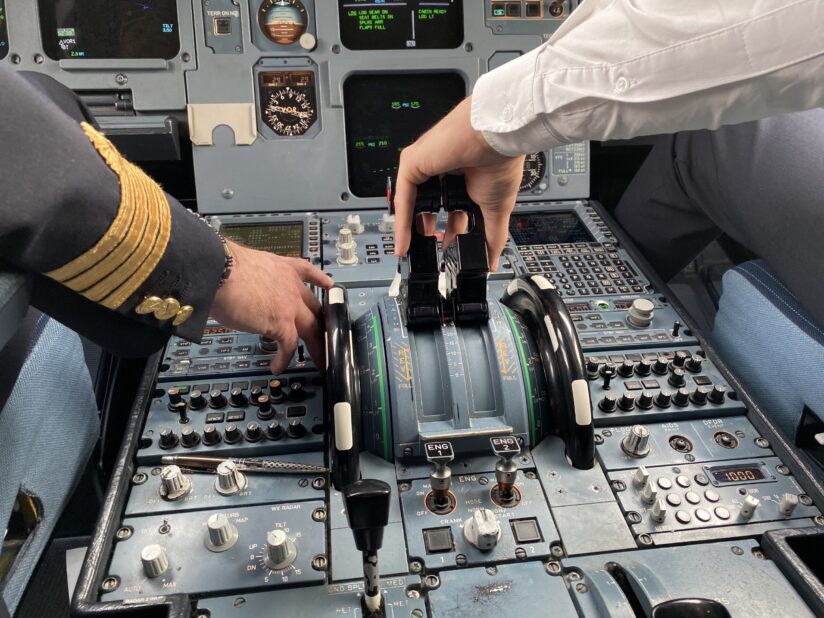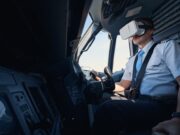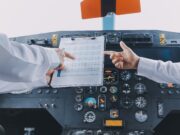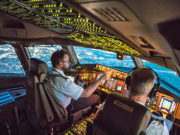
Aircraft accidents and incidents today are normally attributed to multiple causes. Indeed, there is rarely one single cause of an accident. Where does the system fail? High workload, crew fatigue, mismanagement of automation and other factors all play a role. Ultimately, however, handling the airplane manually often comes into the picture. Even though pilot handling skills are rarely a stand-alone factor, there is industry concern about the possible degradation of those skills.
According to Yann Renier, head of training and licensing at the International Air Transport Association (IATA), “In the wake of some high-profile accidents around the turn of the last decade, the industry has mandated extra training for upset prevention and recovery (knowledge and simulator) and we do think this training, combined with the strong awareness efforts, has contributed to improvements in safety. … Additionally, IATA supports global promotion and implementation of competency-based training and assessment (CBTA) that includes evidence-based training [EBT] with the goal to enhance operational safety. Under CBTA and EBT programs, the pilot’s competencies are continuously developed, and pilots are more resilient when facing unforeseen situations.”
Arunas Miezanskas, head of training at BAA Training, adds, “Evidence from high-profile accidents in the last decade indicates that the skill required during a critical phase of flight or to correct an upset has been substandard. Pilot’s experience is counted in hours and may not necessarily be the accurate measure of their skill level. Long-haul pilots can fly around 900 hours a year, but out of this total, a very small part is committed to manually flying the aeroplane.”
FlightSafety International says that pilot handling skills may be affected by the introduction of modern, more complex aircraft systems and avionics, and increasingly congested and complicated airspace systems are placing additional demands on pilots. This requires a different focus on training flight crewmembers.
Even without considering new complexities introduced by the COVID-19 pandemic, “today’s pilots are flying in a more demanding environment compared to just a few years ago, due in part to the number of tasks required and the added complexity,” the organization says.
Automation Dependency
At the latest Assembly of the International Civil Aviation Organization (ICAO), the United States and other nations presented a working paper to address automation dependency, which is associated with the increasing level of flight deck automation over the past several decades.
“Raising and harmonizing pilot training standards across the globe are among the [U.S.] Federal Aviation Administration’s (FAA’s) top aviation safety priorities,” the FAA says. ““We continue to pursue expanded conversations among the world’s aviation regulators to identify ways to enhance international aviation safety through robust pilot training programs.”
Miezanskas notes that, in 1997, “American Airlines produced a video on the overdependence on automation by pilots. The phrase ‘children of the magenta’ [a reference to some pilots’ focus on monitoring the magenta lights on display screens] was coined from this video, which indicated at this early stage that pilots were over-reliant on automation. Pilots have now adapted to flying with the automation engaged, but not adequately monitoring its performance.”
Increased automation in the flight deck is enhancing safety in flight operations and is also beneficial in terms of flight efficiency – for example, in implementing reduced vertical separation minimums – and comfort of flight. This implies that pilots are focusing on different tasks than they did in the past.
“The general trend is to use the maximum level of automation during flight; however, this might contribute to a less active participation in manual aircraft handling and, at times, to an over-reliance on automation,” says the European Union Aviation Safety Agency (EASA). “It is important to seek a balance in training of automation and manual flying skills to address the situation where, if automation systems do not work as intended, pilots are adequately skilled and confident to take manual control of the aircraft.”
Sunjoo Advani, president of International Development of Technology, says his organization has been informed about “upticks in trends of hard landings and runway excursions, as well as pilot reactions to in-flight upset events. Ultimately, if the pilot does have to fly manually, s/he must be aware of the aircraft handling characteristics, and, arguably, not just during the final seconds before landing.”
He adds, “One factor is the lack of familiarity of pilots with handling large aircraft manually, other than on takeoff or short final. We learn ‘manual’ flying in general aviation aircraft, with very different properties compared to big jets. Once a pilot reaches the airline, more focus is placed on the complex procedures and operations, rather than manual flying. Consequently, pilots of large aircraft rarely have the opportunity of actual ‘manual flight,’ particularly at higher altitudes, in the rare event that this is required. Some airlines may also discourage manual flying during the approach phase.”
Simulator training is essential to help prepare flight crews to react correctly in these situations and to maintain the highest level of safety, currency and proficiency, FlightSafety International says.
“Some pilots rarely fly without the use of automation,” the organization says. “As a result, we, and many of the flight departments we serve, are focused on training that addresses this shift. This can result in additional time spent during simulator training focused on ensuring proficiency with manual flying skills.”
Advani points out that crew training is moving toward a more holistic view of handling skills as part of the overall set of competencies required to safely perform flight operations.
“If one takes, for example, a runway overrun or a hard landing, this could be attributed to the flare execution,” he says. “But what happened before the flare? Even if the approach was stable, factors other than just the handling skills alone could have come into play: the actual weather conditions during the approach, runway visibility and surface conditions, how the crew manages the approach, and even the airline’s training/operations policies. Hence, the handling skills are not isolated and must be seen as an integral part of the entire operation.”
Areas of Attention
Safety events in the past triggered safety recommendations, which in turn led to additional maneuvers-based training. As an example, the go-around phase has been identified as a critical point at which workload and aircraft handling might become demanding if combined with certain weather or operational conditions.
“For this reason, we have placed an emphasis on the need to train items such as a go-around with all engines operating or a landing rejection below decision height,” says EASA. “Furthermore, the UPRT [upset prevention and recovery training] package was designed to equip the flight crews with more solid competence to manage, by use of manual recovery, the onset of undesired aircraft states. The integration of training elements starts from the early stages of training [and continues] up to the operator’s recurrent training.”
According to FlightSafety International, areas that are often emphasized during recurrent training include single-engine handling in multi-engine aircraft, instrument procedures without automation, approaches with circle-to-land maneuvering, and situations that require the use of emergency procedures. “Doing so increases safety, confidence and proficiency in areas seldom practiced or too high-risk to practice in the actual aeroplane,” says FlightSafety International.
Some pilots may never have experienced a go-around or missed approach in an aircraft type that is new to them, except in the simulator.
“All pilots should, nevertheless, be aware that any approach could end in a go-around due to a variety of factors (high-energy approach, blocked runway, turbulence, wind outside limits),” Miezanskas says. “The go-around requires a briefing from the pilot flying to the pilot monitoring, telling … what his/her actions will be in this event.”
Self-Awareness
There is significant variation in the pilot population as to the perception of actual or potential erosion of manual skills.
“While a few pilots may not be aware of the degree of degradation of proficiency, those who are highly experienced and proficient recognize and value the importance of twice-a-year simulator training,” FlightSafety International says. Experiencing a maneuver that requires improvement during recurrent training is to be expected, as this helps pilots reach and maintain peak proficiency in all areas of operation.”
Miezanskas notes that some airlines may restrict the practice of manual handling skills due to their records of incidents attributed to manual flying
“Pilots in these airlines feel limited by this restriction and voice concern over their inability to practice and sharpen their manual flying skills,” he says. “Other airlines are less restrictive but do require a specific time and a place for such practice, with the simulator being the safest place. In the non-jeopardy environment of simulation, many varied and challenging scenarios can be given to pilots to advance their skills and improve their manual flying abilities. This gives pilots the confidence and the opportunity to operate with the automation and to be aware of the limitations in their manual flying skills.”
Advani underscores the importance of understanding the possible consequences during the transition from automated to manual flight in maintaining a higher level of situation awareness and to preventing surprise or startle.
“In order to train pilots to intervene before an actual upset develops, we introduced ‘awareness’ and ‘recognition’ as the two mitigation levels of ‘prevention,’” he says. “The aim of these is to improve pilot knowledge, skill and confidence, and thereby reduce the risk of startle.”
Automation and Technological Upgrade
Automation and the technological upgrade of aircraft are often regarded as leading factors of the possible degradation of pilot handling skills. However, there are ways automation and technology can support pilots in the development and maintenance of their handling skills.
“Fly-by-wire and envelope-protected aircraft empower the pilot with an added safety net,” Advani says. “During routine flights, these aircraft operate under ‘normal’ law or mode with the protection systems engaged. The pilot can safely operate, knowing the airplane will suppress undue excursions. … Nonetheless, understanding how the protection systems work and, more importantly, understanding the basic principles of aerodynamics, energy, trim, performance limitations and several other factors are crucial. While these skills may not be routinely exercised in operations, it is during that very small percentage of events when those skills are required that things could otherwise go wrong.”
Transport Canada (TC) says that automation results in a reduction of direct pilot input on the controls.
“The operator’s recurrent training program, which is reviewed and approved by Transport Canada, includes mandatory modules where the pilot must fly manually in simulated abnormal or emergency scenarios involving automatic flight systems,” TC says. “These scenarios require a hand-flown approach and landing, and the pilot candidate is graded on that performance. Where necessary, additional training will be conducted to ensure satisfactory performance. As many accidents occur during the takeoff and landing phases, a pilot not possessing these handling skills would not be acceptable for flight operations due to safety and liability reasons.”
Automation is a valued support of the pilot when he or she is engaged and aware of what the automation is doing.
“Situational awareness needs to be maintained by using automation as an extension of the pilot’s ability and the pilot deciding the level and amount of automation to be used to effect a safe flight. The pilots must pick the right time and place to practice their manual flying,” says Miezanskas. “There is a fine balance to be managed here; the use of automation in a busy terminal control area … would be recommended; then, the practice of the manual flying skills on a clear day with very little terminal traffic would be preferential. The pilot flying should brief the pilot monitoring, and the pilot monitoring should call out any deviations from this brief.”
According to EASA, the use of automation and innovation has led, and is still leading, to a significant safety improvement with the development of flight envelope protection and other operational safety nets (such as runway overrun protection systems, automatic traffic-alert and collision avoidance systems, and automatic emergency descent systems). “The same applies to the training industry which takes benefit from updated technology, innovations and studies,” EASA says.
Renier says that advanced technology is already included in flight synthetic training devices (FSTD, also known as flight simulation training devices) – including full flight simulators (FFS) – “to get more objective data about pilot competency related to flight path management, manual control and automation. Other initiatives, which are more of research and development at this stage, are related to eye-tracking to assess pilot visual pattern or voice recording to support the instructor assessing pilot competencies such as leadership, teamwork and workload management.”
The latest standards developed by EASA for FFS aim at reaching an increased fidelity level within the training envelope for UPRT with enhanced data and models at high altitude, in icing conditions or when approaching a stall. “The agency is willing to support the further development of standards to include the use of new tools such as virtual or augmented reality capable of immerging pilots in a more dynamic learning environment with a wider and more sustainable availability,” says EASA.
Training Programs
Crew training program concepts are evolving to enable pilots to better develop and maintain handling skills.
“Training courses are revised based on customer and regulatory requirements, as well as the introduction of new technology and a changing operating environment,” FlightSafety International says. “An example is UPRT, which is currently required by several national aviation authorities to be integrated into initial flight curricula. Additionally, insurance or risk management groups can also dictate what the aircraft operator must successfully complete in training to obtain insurance coverage on their airframe.”
There is now particular emphasis in simulator programs for pilots to manually fly the airplane.
“The focus is to ensure the pilots are not only proficient but also prepared for scenarios where hand-flying may be necessary,” says FlightSafety International.
“Airlines are now practicing go-arounds from various heights on the approach and in various configurations to get pilots thinking about what is required,” Miezanskas says. “Pilots are also performing visual circuit patterns, circling approaches and UPRT to address their manual handling skills. This comes at a time when the emphasis in the industry is on performance-based navigation (PBN), which relies heavily on automated flight.”
An important initiative has been the introduction and implementation of pilot competencies.
“CBTA is becoming widely accepted. Conventional training has been ‘inputs’-based, whereby specific time was allocated to achieving qualification,” Advani says. “With CBTA, the outcome dictates success instead. By understanding the interconnectivity of all the competencies, one can focus more on a safe outcome.”
The development of CBTA aims at developing the full scope of competencies that are required to manage more automated systems.
EASA says that it supports establishment of an ICAO study group to collect and evaluate data on manual flying and to verify the effectiveness of safety standards and guidance materials related to situations requiring pilots to resume manual flight.
“The current training and checking programmes address the proficiency in manual handling skills through specific manoeuvres to be conducted within prescribed flight parameters tolerances,” EASA says. “Practising and testing these manoeuvres in a FSTD is one way to ensure the necessary competence retention.”
Additionally, EBT, as well as alternative qualification programs, are penetrating the industry, whereby tasks specific to an airline’s operations or safety issues are given higher priority on a case-by-case basis.
“Automated systems may not deliver their intended function or might revert to modes that can be challenging for pilots” EASA says. “Under such circumstances, the psychological and cognitive reactions to an unexpected event play a critical role in maintaining control of the situation and preventing aircraft upsets. This is best addressed through competence and evidence-based training.”
In 2009, when the term upset prevention and recovery training was introduced, the intent was to focus on prevention or undesired aircraft states.
“This was a clear departure from the prior adage of ‘upset recovery” or ‘unusual attitude’ training,” Advani says. “If, for example, a pilot applies a control input and the wings stay level, this is also an undesired situation. With this broader context, we have convinced the industry to think differently and rationally. It is also important to make sure we address these issues as early as possible in a pilot’s career, and as early as possible before an event becomes a dangerous incident. Developing these competencies through properly trained instructors is the key to better awareness, recognition and if required, recovery skills.”
Image: Sunjoo Advani
Dr. Mario Pierobon is a safety management consultant. He was recently awarded his Ph.D.


